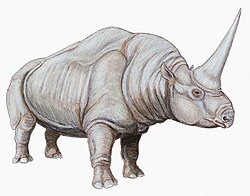| Hesperotherium Temporal range: Early to Middle Pleistocene | |
|---|---|
| Scientific classification | |
| Domain: | Eukaryota |
| Kingdom: | Animalia |
| Phylum: | Chordata |
| Class: | Mammalia |
| Order: | Perissodactyla |
| Family: | † Chalicotheriidae |
| Subfamily: | † Chalicotheriinae |
| Genus: | † Hesperotherium Qiu Zhan-Xiang, 2002 |
| Species: | †H. sinense |
| Binomial name | |
| †Hesperotherium sinense Qiu Zhan-Xiang, 2002 | |
Hesperotherium is a genus of chalicotheres from the Early to Middle Pleistocene of China. Along with Nestoritherium , it was one of the last of the chalicotheres to ever exist. It belonged to the subfamily Chalicotheriinae, which also includes Anisodon , Chalicotherium and Nestoritherium. [1]









